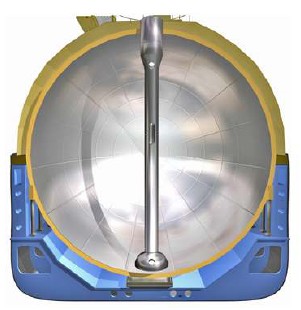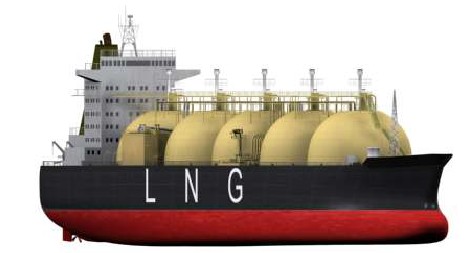
Fig:LNG carrier moss tanks cross section
Tank Insulation
Thermal insulation must be fitted to refrigerated cargo tanks for the following reasons:
• To minimise heat flow into cargo tanks, thus reducing boil-off.
• To protect the tanker structure around the cargo tanks from the effects of low temperature.
Insulation materials for use on gas carriers should possess the following main characteristics:
• Low thermal conductivity.
• Ability to bear loads.
• Ability to withstand mechanical damage.
• Light weight.
• Unaffected by cargo liquid or vapour.
The vapour-sealing property of the insulation system, to prevent ingress of water or water vapour, is important. Not only can ingress of moisture result in loss of insulation efficiency but progressive condensation and freezing can cause extensive damage to the insulation. Humidity conditions must, therefore, be kept as low as possible in hold spaces. One method to protect the insulation is to provide a foil skin acting as a vapour barrier to surround the system.
Thermal insulation may be applied to various surfaces, depending on the design of the containment system. For Type 'B' and 'C' containment systems, insulation is applied directly to the cargo tank's outer surfaces. For Type 'A' cargo tanks insulation can be applied either directly to the cargo tank or to the inner hull (if fitted) although its application to the cargo tank is more common.
As most insulation materials are flammable, great care is required at times of construction or refit to ensure that fires are avoided.
Related Information:
- Gas cargo containment systems - primary barrier (the cargo tank),secondary barrier, thermal insulation and more
- Preparatory operations of drydocking for LNG carriers
Gas cargo containment systems - primary barrier (the cargo tank),secondary barrier, thermal insulation and more
Preparatory operations of drydocking for LNG carriers
Procedure for transporting remote gas
Development and potential of todays emerging gas technologies
Transporting economically viable compressed gas liquids from remote fields
The risk of laden voyage - a brief guide to liquefied gas carriers
Connection and disconnection of cargo hoses and hard arms
The risk of ballast voyage - a brief guide to liquefied gas carriers
The risk of laden voyage - a brief guide to liquefied gas carriers
External links :
// Home page/// LNG handling /// LPG handling/// Sea transport /// Gas products///
Cargo work ///Fire precautions ///Health hazards ///Safety Precautions
///Emergency response ///
Copyright © Liquefied Gas Carrie.com All rights reserved.
The content published in this website are for general reference only. We have endeavoured to make the information as accurate as possible but cannot take responsibility for any errors. For latest information please visit www.imo.org . Any suggestions, please Contact us !
///Links &Resources // Terms of use/// Privacy policy///Home page///
